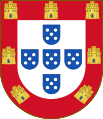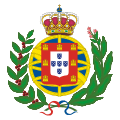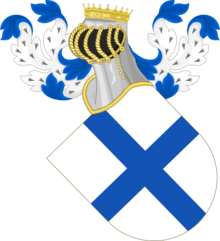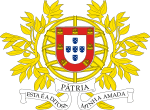Coat of arms of Portugal
| Coat of arms of Portugal | |
|---|---|
 | |
| Versions | |
|
Lesser arms, used on the national flag and governmental flags of the Republic | |
|
Coat of arms used in the military colors | |
| Details | |
| Armiger | Portuguese Republic |
| Adopted | 30 June 1911 |
| Escutcheon | Argent, five escutcheons in cross azure each charged with as many plates in saltire, all within a bordure gules charged with seven golden triple-towered castles |
| Other elements | Behind the shield, an armillary sphere between two olive branches embowed Or bound together in base by a ribbon vert and gules. |
The coat of arms of Portugal is the main heraldic insignia of Portugal. The present model was officially adopted on 30 June 1911, along with the present model of the Flag of Portugal. It is based on the coat of arms used by the Portuguese Kingdom since the Middle Ages. The coat of arms of Portugal is popularly referred as the Five Quinas or simply the Quinas (quinas being the Portuguese term for quincunxes).
History and meaning
The Portuguese coat of arms is the result of almost a millennium of modifications and alterations. Starting with Count Henry, blue cross on a silver shield, successive elements were added or taken, culminating with the complex heraldic design that was officially adopted in 1911 (after the Republican Revolution of 1910). The two stripes bear the colours of the Portuguese flag: red and green.
Quinas
After the official recognition of the Kingdom of Portugal as an independent country in 1143 (it had been self declared as so in 1139), silver bezants were added to the blue cross of the shield, symbolising coins and the right of the monarch to issue currency, as leader of a sovereign state. Eventually, and given the enormous dynamism of medieval heraldry, it is believed that the shield degraded and lost some elements in battle, eventually losing the cross format. This is how King Sancho I inherited the shield from his father, Afonso Henriques, with the cross replaced by escutcheons with the silver bezants. A traditional legend explains that these escutcheons represent the five moor kings defeated by King Afonso I of Portugal in the battle of Ourique.
The number of silver bezants in each escutcheon varied extensively, with versions having represented from four up to eleven. In the late 14th century however, the number of bezants was fixed in five. Late explanations interpret them as the five wounds of Jesus Christ and/or the thirty pieces of silver (with the five bezants in the middle escutcheon counted twice), although this is highly improbable.
From the fixation of the number of bezants in five, each of the escutcheons of the Portuguese shield became popularly referred as a quina (quincunx). By synecdoche, the term "Five Quinas" or simply the "Quinas" came to be used as an alternative designation of the coat of arms of Portugal and came even be used as a reference to anything that represents Portugal (e.g. the Flag of Portugal being often referred as the "Flag of the Quinas").
Castles
It was during the reign of Afonso III that the red bordure with golden castles (not towers, as some sources state) was added. Although the number of castles could vary between eight and twelve, Afonso IV would define them as twelve, and Sebastian I would finally fix them as seven. They supposedly represent the Moorish castles conquered by the Kingdom of Portugal during the Reconquista. Their origin is probably Castilian, but unlike Spanish castles, which usually have their gates coloured blue (hence opened), Portuguese castles were always depicted with gold gates (hence closed). As a matter of fact, Afonso III was the second son of King Afonso II of Portugal and thus was not expected to inherit the throne, which was destined to go to his elder brother King Sancho II of Portugal. As a second son, the coat of arms of Afonso III included both the arms of his father and the arms of his mother Urraca of Castile, thus the Castillan red border with golden castillan castles, around the Portuguese shield inherited from his father.
Armillary sphere
An important element of Portuguese heraldry since the 15th century, the armillary sphere was many times used in Portuguese naval and colonial flags, mainly in Brazil. It was a navigation instrument used to calculate distances and represents the importance of Portugal during the Age of Discovery, as well as the vastness of its colonial empire when the First Republic was implemented.
Although it is commonly used as a "republican" element, as opposed to the monarchist crown in the blue/white flag (see Flag of Portugal), some monarchist flags, such as the flag of the United Kingdom of Portugal, Brazil and the Algarves, already depicted armillary spheres. The incorporation of the armillary sphere into the 1816 flag of the United Kingdom of Portugal is related to the adoption of the first flag of the Kingdom of Brazil, an armillary sphere on a blue background.
Crowns
The coat of arms sported different crowns during imperial rule of Portuguese and foreign crowns.
- Before the mid-16th century, the coat of arms had an open imperial crown
- Crown of the House of Habsburg
- Various crowns of the House of Braganza (1640–1817)
- Crown of João VI (1817–1910)
Evolution of the Portuguese shield
.png) 1095-1139 (hypothetical)
1095-1139 (hypothetical).png) 1139-1247 (first historic Coat of arms)
1139-1247 (first historic Coat of arms).png) 1248-1385
1248-1385.png) 1385-1481
1385-1481.png) 1481–present
1481–present
Royal Coats of Arms of Portugal
.png) Greater royal coat of arms
Greater royal coat of arms The lesser royal coat of arms
The lesser royal coat of arms Coat of arms of the Kingdom of the Algarve
Coat of arms of the Kingdom of the Algarve Coat of arms of the United Kingdom of Portugal, Brazil and the Algarves
Coat of arms of the United Kingdom of Portugal, Brazil and the Algarves Coat of arms of the Portuguese House of Burgundy
Coat of arms of the Portuguese House of Burgundy- Coat of arms of the House of Aviz
.svg.png) Coat of arms of the House of Habsburg
Coat of arms of the House of Habsburg Coat of arms of the Dukes of Braganza until 1640
Coat of arms of the Dukes of Braganza until 1640
See also
| Wikimedia Commons has media related to Coats of arms of Portugal. |
- Portuguese heraldry
- Flag of Portugal
- History of Portugal
- Coats of arms of Portuguese colonies
- Coat of arms of Ceuta
.svg.png)


